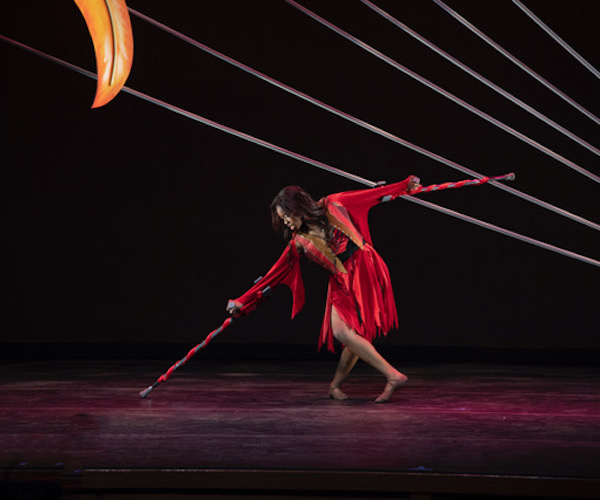Dance Review: Abilities Dance Boston’s “Firebird Ballet” — Taking Inspiring Flight
By Jessica Lockhart
Re-envisioning and performing this beloved classic ballet with dancers that identify as disabled seems to me to be the definition of courageous.
Abilities Dance Boston, Firebird Ballet at the Boston Wimberly Theatre at the Calderwood Pavilion, May 14 and 15.

Abilities Dance Boston’s Firebird. The Princess Scene. Photo: Mickey West Photography
Abilities Dance Boston, a company whose mission is to challenge the notion of who gets to dance, decided to tackle a ballet classic: Igor Stravinsky’s The Firebird, which was written for the 1910 Paris season of Sergei Diaghilev’s Ballets Russes company. As I began to watch one of the company’s livestream performances, I realized I was hearing a voice describe every detail of what was happening on stage: “Their arms are lifting, making full circles, wrists cross. They leap and move to the right side, then to the left.” Then I noticed a sign language interpreter in the bottom corner of the screen. It made me stop and think: I was not used to such accommodations for the disabled, in a dance performance. It was a humbling realization, and then I thought yes, the arts — and especially ballet, with its rigid training for dancers and expectations of perfection — needed now, more than ever, to reach for equality. Artists need to let go of old habits, to find new ways to think, see, and perform. Abilities Dance offers a great example of how the arts and culture community can begin to address inequity.
Abilities Dance Boston’s founder, executive and artistic director Ellice Patterson, supplied the show’s new choreography (in collaboration with the dancers). The Firebird was inspired by Russian folk traditions. It tells the story of a prince who falls in love with a princess who is held captive by an evil sorcerer. A beautiful and mysterious bird helps the prince rescue his love by lulling the sorcerer into a dance to the death that destroys his power, thus freeing the princess.

Abilities Dance Boston’s Ellice Patterson in Firebird. Photo: Mickey West Photography
In her reimagined production, Patterson took on the role of the firebird, which is an exotic fantasy figure, neither male or female. Patterson wore a bright red costume that included red striped forearm crutches, which created a giant wing span. Zahna Simon and Antoine Hunter, guest performers from California’s Urban Jazz Dance Company, danced the roles of prince and princess. Hunter is deaf and Simon is an interpreter — together they brought the experience of deaf and disabled culture into the performance. Patterson’s choreography made a self-conscious effort to bring disabilities into the fairy tale. The story was not changed. According to the program notes, Andrew Choe’s original score follows the story exactly, moving from mystical curiosity to passionate excitement, eventually arriving at intense struggle and introspection.
It was inspiring to watch this performance, which was danced expertly, with adroit technical skill. The role of the evil queen was danced by Louisa Mann and the dance corps company featured Lauren Sava, Jamie Desser, Leslie Taub, Drew Genova, and Bradford Chin. The corps dancers played dual roles; they were aides to the evil queen as well as the minions who aided the sorcerer — they too danced themselves to death. When the firebird reappeared on stage — as a transcendent image of healing — she came onstage in a wheelchair. Patterson moved slowly, rolling the chair through the use of her forearm crutches. She slowly pushed herself off the wheelchair and moved her body around the stage with the help of the crutches, making slow deep lunges and sweeping gestures with her arms and legs. Janie E. Howland’s set included a huge feather on stage, a metaphor for the ever-rising phoenix. Provocatively, there was a replica of Boston’s iconic Zakim Bunker Hill Memorial Bridge as well — but it is turned upside down.
Boston University professor and author Ibram X. Kendi, who wrote the bestseller How to be an Antiracist, recently spoke at a commencement ceremony. He posed a question to the graduates: Do you want to live a courageous life, or do you want to be ruled by fear? His challenge came to mind as I watched this performance of The Firebird. Re-envisioning and performing this beloved classic ballet with dancers that identify as disabled seems to me to be the definition of courageous. Let a thousand firebirds bloom.
Jessica Lockhart is a National Endowment for the Arts Fellow in Dance Criticism and has a BA in Communication from the University of Southern Maine. Lockhart is a Maine Association of Broadcasters award-winning independent journalist. Currently, she also works as program director at WMPG Community radio.
Tagged: Abilities Dance Boston, Ellice Patterson, Firebird Ballet
